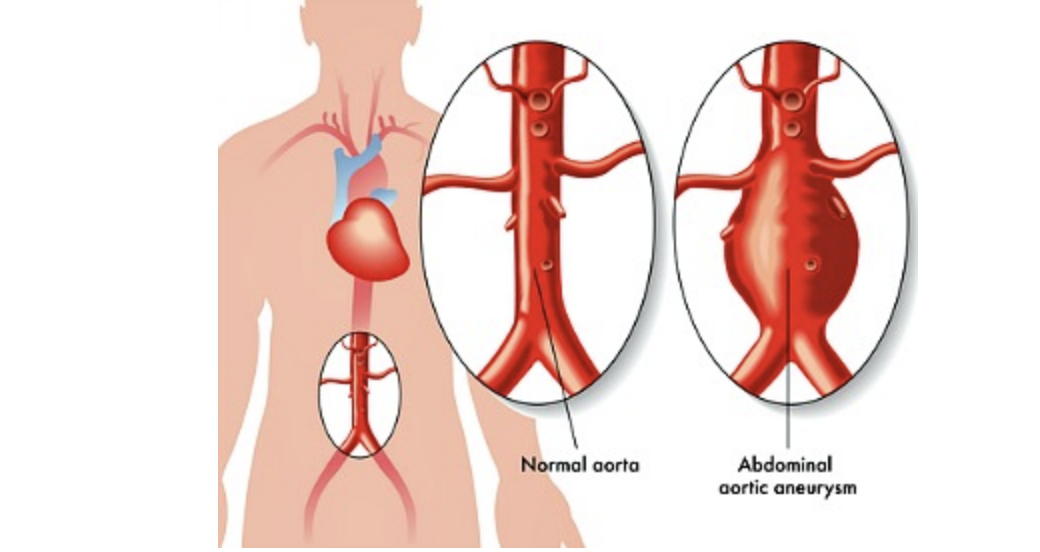Sign up to our newsletter!
Abdominal Aortic Aneurysm Symptoms
Abdominal aortic aneurysm symptoms include central or left lower abdominal ache that radiates to the back, with associated dizzy spell and collapse. Find out more here if this could be the cause of your symptoms.

Abdominal aortic aneurysm symptoms are usually completely silent at the beginning stages of this condition.
So many who have developed abdominal aortic aneurysm (also referred to as AAA or triple A for short) may never know they have it.
The diagnosis is often an accidental finding when doing an abdominal x-ray or ultrasound or even CT scan for other unrelated issues.
What Is Abdominal Aortic Aneurysm?

Abdominal aortic aneurysm is the abnormal ballooning of a section of the aorta inside the abdomen.
The aorta is the big blood vessel that carries blood from the heart down to the rest of the body.
It arches out of the upper part of the heart and beds towards the left side of the midline of our chest and then descends down a few inches below our navel or umbilicus before it bifurcates and spreads out into two branches that goes into the groin to form what we call the iliac arteries.
Due to abnormality in the wall of the aorta, it could lose its normal resilience and elasticity, causing it to become permanently distended.
As the distention worsens, it creates further pressure on the wall of the aorta, leading to further thinning of wall, and eventually, a small leak or outright rupture of the aorta.
If found in good time, this abnormal ballooning can be repaired safely with no significant long term sequelae. A late diagnosis could be dangerous.
Typical Symptoms of Abdominal Aortic Aneurysm
A small continuous leak of the aorta would lead to seepage of blood into surrounding abdominal cavity. Blood is an irritant to the bowels and abdominal cavity in general. As the amount of blood increases, this would lead to symptoms of abdominal aortic aneurysm.
It is therefore safe to say that by the time the symptoms of AAA is evident, it is almost too late.
The classic symptoms of aneurysm of the abdominal aorta include:
- Dull ache in the central or lower abdomen that spreads to the lower back
- Sometimes, the pain could be originating in the left lower abdomen or groin and spreads to the back
- Dizziness or fainting episodes on standing up
- Where a significant bleed has already occured, patient could develop shoulder tip pain
- Sudden collapse and death are hallmarks of a catastrophic rupture of the abdominal aorta.
In Whom Should You Suspect Abdominal Aortic Aneurysm Symptoms?

As you would imagine, the above symptoms of abdominal aortic aneurysm are not specific to this condition.
Abdominal aortic aneurysm does not happen in everyone.
Abdominal aortic aneurysm symptoms are more likely in someone with risk factors for this disease. These include being:
- At least 50 years of age and above. It is more likely to happen the late 60s to 80s
- Male. AAA or Abdominal aortic aneurysm does happen in women but it is more likely to occur in a man than in a woman
- A smoker or smoked heavily in the past. It is said that it is very rare for anyone who had never smoked to develop a ruptured abdominal aortic aneurysm
- Someone with a family history of abdominal aortic aneurysm
- Known with hypertension or and high levels of cholesterol in the blood.
If you or your loved one have any of the above listed risk factors, and experiencing the listed abdominal aortic aneurysm symptoms, you must call for urgent medical attention.
Now What Next?
If you suspect the presence of AAA, speak with a doctor as soon as possible. You may require:
- A complete physical examination to help establish the likelihood of this
- An abdominal ultrasound or CT-Scan
- Abdominal X-ray where the above facilities does not exist.
Once confirmed, if the abdominal aortic aneurysm is less than 5 cm in its widest diameter, you may require no surgery.
If it is more than 5 cm then surgery may be required to fix this abnormality.
Stay Connected






New! Comments
Have your say about what you just read! Leave me a comment in the box below.